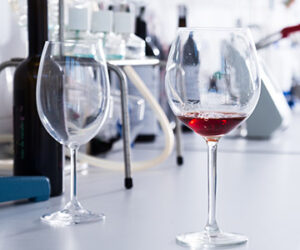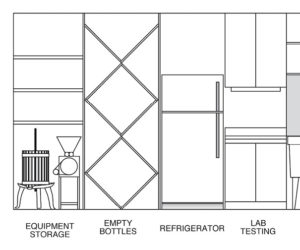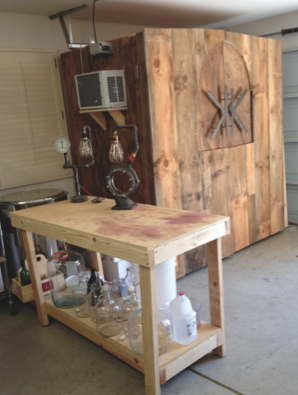 I was introduced to making homemade wine by my neighbor. After tasting his Cabernet Franc, I was hooked. My neighbor, Grant, is quite accomplished in his winemaking, having won many gold medals and best of shows.
I was introduced to making homemade wine by my neighbor. After tasting his Cabernet Franc, I was hooked. My neighbor, Grant, is quite accomplished in his winemaking, having won many gold medals and best of shows.
Grant accepted my offer to help with winemaking duties on the upcoming harvest. I soon learned the amount of labor that went into picking a ton of grapes and scooping them into the angry machine called the crusher. A few weeks later, Grant called and the fermentation had been completed and it was time to press. I learned the joys of pressing and removing the pulp. My grape stained hands left no doubt that I got my hands dirty. After a few days of settling, the wine went into barrels, which were stored comfortably in Grant’s air conditioned, subterranean wine cellar. That vintage, which was bottled 12 months later, proved to be something special.
It took little effort to convince the Mrs. that home winemaking was an upgrade to my current hobby — classic car restoration. My nicely restored 1972 Triumph TR6 soon found its way onto the market and within a few weeks I had the seed money to fund my new winemaking hobby. My goal is to make excellent wine, in sufficient quantity that I can enjoy with family and friends. This goal drove my decision to make wine from grapes and age the wine in barrels. I wanted to be as self sufficient as possible, so I knew I was going to need some basic winemaking equipment.
Within a month, I found a Craigslist ad from a home winemaker who was exiting the hobby and the ad seemed to list all the bits and pieces that I needed. I grabbed a pocket full of cash and drove my truck to take a look. There was a lot of equipment and it was well cared for. I asked “how much for everything?” and we made a deal.
While the pick-up truck full of equipment contained a destemmer/crusher and a press, I knew that I still had a significant issue to deal with, which was cold storage. I live in California’s Sierra Foothills where summer temperatures regularly run in the 90s and low 100s Fahrenheit (35 to 40 °C). One option was to rent cold storage space, but the cost ran about $1,000 per year and it was not convenient to go to the storage space every time I wanted to test or top the barrels. I looked at building a separate room within my garage, but I didn’t have the space and I didn’t want something permanent. This lead me to build a storage box that was standalone, met my technical needs, had the necessary capacity, was economical to run, and was built within a reasonable budget.
I heard a saying that if you ask ten winemakers a question, that you will get eleven different answers. I found this to be true about the impact of temperature on wine storage. Fifty-five degrees Fahrenheit (13 °C) and seventy percent humidity seemed to be the standard, especially when storing wine for decades. I hope to be able to make a wine someday that is worthy of storing that long. After reading numerous technical papers on wine storage temperatures and the impact on wine aging, I felt that storing my barrels and bottles in an area that stayed in the 60s Fahrenheit (15 to 20 °C) would meet my needs and not cost an excessive amount to cool during the summer months. I also found in my research that maintaining a constant temperature was very important. Thus I came up with this design for a temperature controlled “box” that would fit in my garage, where I could set my control unit to turn on at 69 °F (20 °C) and turn off at 65 °F (18 °C). I measured the temperature change inside the bottle when the external temperature cycled four degrees (2 °C) and the temperature inside the bottle only varied around 1 degree (0.5 °C).
I built the wine storage unit in my garage using a chop saw and hand tools. I used all screws and built the unit in big panels. I did this so that if I do want to move it someday, that it can be disassembled and moved in sections (albeit very heavy sections).
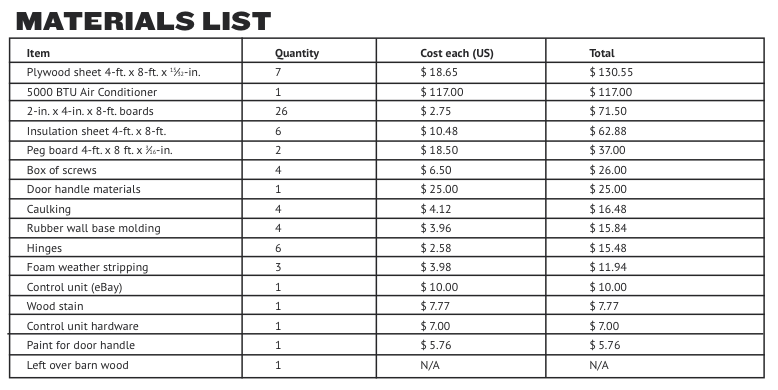
Photo 1: Dimensions
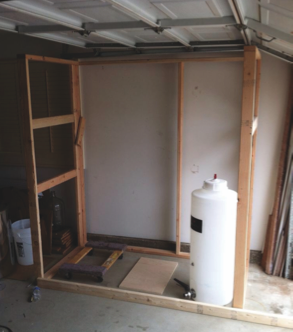 The height (86 inches/218 cm) of the unit was dictated by the garage door; I needed to be able to open and close the garage door without interference. The unit needed to be deep enough to house a 60-gallon (227-L) barrel lengthwise and 50 inches (127 cm) allowed for enough space for the walls and doors.
The height (86 inches/218 cm) of the unit was dictated by the garage door; I needed to be able to open and close the garage door without interference. The unit needed to be deep enough to house a 60-gallon (227-L) barrel lengthwise and 50 inches (127 cm) allowed for enough space for the walls and doors.
The decision of the width (82 inches/208 cm) allowed enough space for two 60-gallon barrels or one 60-gallon (227-L) barrel and two 30-gallon (113-L) barrels, along with the 30-gallon (113-L) Flextank.
Photo 2: Layout / Shelving
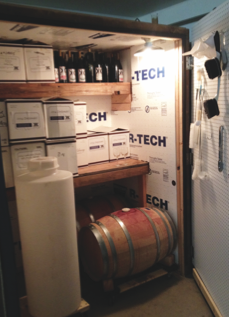 The upper shelving is a foot (0.3 m) wide and was designed for bottle storage, while the bottom shelf is 2 feet (0.6 m) wide and was designed for storage of carboys and cases of finished wine. I experimented with different layouts for bottle storage, but in the end I went back to a flat shelf that allowed me to store cases of finished wine. The shelves are set back to allow good airflow from the air conditioning to all areas and provide enough space for the Flextank to fit in with the doors closed as well.
The upper shelving is a foot (0.3 m) wide and was designed for bottle storage, while the bottom shelf is 2 feet (0.6 m) wide and was designed for storage of carboys and cases of finished wine. I experimented with different layouts for bottle storage, but in the end I went back to a flat shelf that allowed me to store cases of finished wine. The shelves are set back to allow good airflow from the air conditioning to all areas and provide enough space for the Flextank to fit in with the doors closed as well.
Photo 3: Cooling Fermentation Temperatures
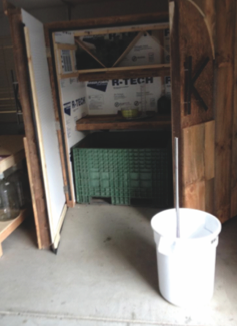 One of the side benefits of having such a large air conditioned space was the ability to reduce the temperature of fermentation by rolling my macro-bin into the wine box. I used foam weather stripping to seal the doors when they are closed. I was looking for an economical and effective way to seal the doors against the floor and made door sweeps and a barrier between the doors out of rubber base molding from Home Depot, which seems to be holding up well.
One of the side benefits of having such a large air conditioned space was the ability to reduce the temperature of fermentation by rolling my macro-bin into the wine box. I used foam weather stripping to seal the doors when they are closed. I was looking for an economical and effective way to seal the doors against the floor and made door sweeps and a barrier between the doors out of rubber base molding from Home Depot, which seems to be holding up well.
Photo 4: AC / Insulation
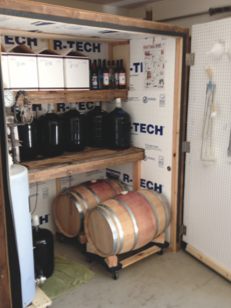 While an air conditioning unit that is designed for wine storage would be ideal, the cost of the unit was not in my budget. The 5000-BTU window unit I got from WalMart was designed to cool a space four times larger than it is being used for, and was less than 10% of the cost of a wine storage air conditioner that I was looking at. An AC unit designed for the house pulls the moisture out of the air at a much greater rate than an AC made for wine storage. With the length of time that my wine will age, I do not anticipate this being an issue. The mold resistant insulated foam board I got from Home Depot has a radiant barrier and was cut to fit. I used caulking around all the edges. Certainly more insulation is better and insulating the floor would also be a benefit. Adding more insulation is an option if you are building a box of your own.
While an air conditioning unit that is designed for wine storage would be ideal, the cost of the unit was not in my budget. The 5000-BTU window unit I got from WalMart was designed to cool a space four times larger than it is being used for, and was less than 10% of the cost of a wine storage air conditioner that I was looking at. An AC unit designed for the house pulls the moisture out of the air at a much greater rate than an AC made for wine storage. With the length of time that my wine will age, I do not anticipate this being an issue. The mold resistant insulated foam board I got from Home Depot has a radiant barrier and was cut to fit. I used caulking around all the edges. Certainly more insulation is better and insulating the floor would also be a benefit. Adding more insulation is an option if you are building a box of your own.
Photo 5: AC Control Unit
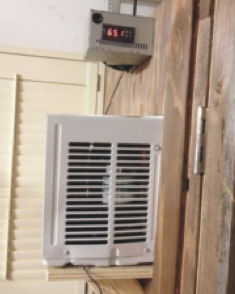 The brain of the wine storage box is an inexpensive controller that I purchased from eBay for $10. The controller has a thermocouple that is run into the wine storage box and located next to the barrels. The controller turns the AC unit on and off based on the temperature the controller is sensing inside the box. I have the controller set to turn on at 69 °F (20 °C) and turn off at 65 °F (18 °C). The AC unit itself has manual controls and I leave it on at the coldest temperature setting so that when power is applied it provides the maximum cooling and air flow. The AC is capable of cooling the box down to 60 °C (15 °C), but maintaining that temperature may be difficult for the AC unit and would also drive additional expense. It is also interesting to note that in the winter, when the garage temperatures drop below 65 °F (18 °C), that the box helps maintain a higher temperature than the ambient temperature in the garage.
The brain of the wine storage box is an inexpensive controller that I purchased from eBay for $10. The controller has a thermocouple that is run into the wine storage box and located next to the barrels. The controller turns the AC unit on and off based on the temperature the controller is sensing inside the box. I have the controller set to turn on at 69 °F (20 °C) and turn off at 65 °F (18 °C). The AC unit itself has manual controls and I leave it on at the coldest temperature setting so that when power is applied it provides the maximum cooling and air flow. The AC is capable of cooling the box down to 60 °C (15 °C), but maintaining that temperature may be difficult for the AC unit and would also drive additional expense. It is also interesting to note that in the winter, when the garage temperatures drop below 65 °F (18 °C), that the box helps maintain a higher temperature than the ambient temperature in the garage.
Photo 6: Cooling Expense
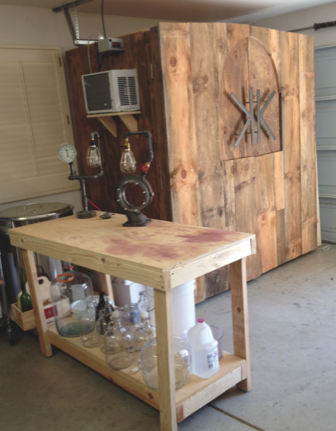 The temperature controller allows me to accurately measure the temperature at the barrel and turn the AC on and off when I want to. The AC unit does not run at all during the five cooler months of the year; November through March. In April, May, and October, the unit only cycles minimally, as the average high in those months is in the 70s °F (~ 23 °C). It is during the summer months, June through September, that the unit earns its keep. Utilizing a “Kill A Watt” meter, I measured the actual energy usage of the controller and the AC unit. When the ambient temperature in the garage is 75 °F (24 °C), the meter records power usage of less than one KW per day. During the peak season, where outside temperatures can be over 100 °F (38 °C) and the ambient temperature of the garage registers over 90 °F (32 °C), the cold storage box typically records usage of around two KW per day. Using a cost of $.20 per KWH, the average cost for me to power the AC unit comes out to less than $8 per month. This provides a convenient and economical solution compared to renting cold storage or building an expensive wine cellar.
The temperature controller allows me to accurately measure the temperature at the barrel and turn the AC on and off when I want to. The AC unit does not run at all during the five cooler months of the year; November through March. In April, May, and October, the unit only cycles minimally, as the average high in those months is in the 70s °F (~ 23 °C). It is during the summer months, June through September, that the unit earns its keep. Utilizing a “Kill A Watt” meter, I measured the actual energy usage of the controller and the AC unit. When the ambient temperature in the garage is 75 °F (24 °C), the meter records power usage of less than one KW per day. During the peak season, where outside temperatures can be over 100 °F (38 °C) and the ambient temperature of the garage registers over 90 °F (32 °C), the cold storage box typically records usage of around two KW per day. Using a cost of $.20 per KWH, the average cost for me to power the AC unit comes out to less than $8 per month. This provides a convenient and economical solution compared to renting cold storage or building an expensive wine cellar.
Photo 7: Finishing Touches
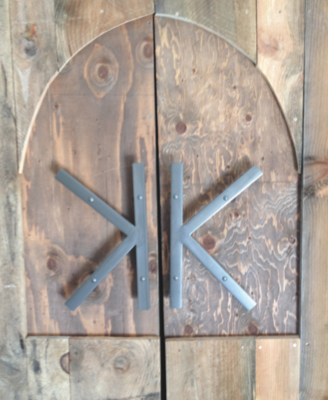 Given that winemaking is part science and part art, I wanted to give an artsy touch to the outside of the box. I stained the plywood sheets and used some old barn wood for the shelves and to dress-up the outside of the box. I angled the boards on the doors to give the unit some shape, so it disguises the big box that it is. The handles are two back-to-back K’s, which stand for for Ken and Kathi, which we design our garage winery logo from. The lamps, that I made from left over parts from a building demo, has a working thermometer and matches the rustic décor.
Given that winemaking is part science and part art, I wanted to give an artsy touch to the outside of the box. I stained the plywood sheets and used some old barn wood for the shelves and to dress-up the outside of the box. I angled the boards on the doors to give the unit some shape, so it disguises the big box that it is. The handles are two back-to-back K’s, which stand for for Ken and Kathi, which we design our garage winery logo from. The lamps, that I made from left over parts from a building demo, has a working thermometer and matches the rustic décor.



